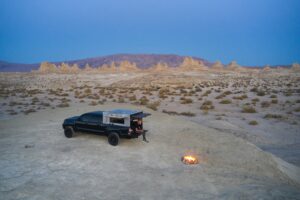Note: This section is only looking at full-size personal vans. Commercial cargo and passenger vans are covered here: Van Life DIY: Transforming Commercial Vans into Tiny Homes. Mini-vans are covered here: Vanonomics: Mastering Minivan Living to Save Big and Travel
Full-size vans (often referred to as “conversion vans” because the factory build was often customized with an after-market raised top and the back converted into something resembling a living room–often with a jack-knife style couch/bed) were very popular back in the 70’s and 80’s, but are now much more difficult to find. They’re mainly used these days for handicapped-accessible vehicles. I believe they were probably popular in the 70’s and 80’s because housing was so incredibly expensive due to high interest rates (sound familiar?) and a recession led to a lot of unemployment and stagnant wages, so young people got trapped living at home with their parents. Vans became a way for young people to have a bit of their own private space. They turned the rear area into a living area (or love nest) and hung out with their friends (or girlfriends) in the only bit of private space they had. The vans lost their primary use when the economy began to pick back up in the mid-80’s and interest rates started falling, so that people were able to start getting their own homes.
But, as we’re repeating this same era of high inflation, high interest rates, and wages not keeping up with either, the conversion van may experience a resurgence. The trend is towards converting commercial vans into mini-campers, but there’s still room for the trusty old conversion van and it may grow in popularity once again in the coming years.
One difference between using a conversion van as opposed to a commercial one is the conversion van will have more windows. Depending on how you want to do your build out, this may be considered a pro or it may be a con. Still, you can block up a window if you need to without too much hassle, whereas putting one in that doesn’t currently exist requires a lot more skill, tools, and work.
Commercial vans are higher inside than a typical mini-van, especially the cargo variety. But a high-top conversion van will rival most commercial vans–and may exceed them–in terms of interior height. So if you are a tall person, be sure to give them consideration; they may be just what you need.
This is a no-build setup inside a conversion van, primarily using furniture the owner already had or was able to get from thrift stores. She spent between $200-$300 on new pieces, such as the mattress and refrigerator. She has one of the larger solar generators and is able to run a microwave and CPAP machine on it.
She also mentioned joining a caravan group to combat loneliness. If you plan on working remotely, but worry that living out of a vehicle or RV will be isolating, search online to see if you can find a caravan group in your area to give you a sense of community. There are some that are all-inclusive, but there appear to be some that cater just to solo women, seniors, young professionals, families, etc., so you may be able to narrow down your caravan group to people closer to your age and circumstances.
This bougie van is high on feminine touches and minimalist everywhere else. It doesn’t feel like living rough or cramped. She prefers a larger bed (unclear if it’s full size or queen), but if you’re comfortable with a twin bed, that would give you more space, such as for a desk so you can work remotely. It also seems a bit short on space for cooking inside (which some people don’t like to do, but you need a plan for inclement weather). Me, personally, besides just going with a twin bed, I would have the toilet pull out from under the bed and use the valuable space next to the seats for a countertop where I can use a one-burner stove.
Some people will replace the standard passenger chair with one that swivels, and this can be a good option for seating in your living space. A TV tray table turns this into your dining room. Alternatively, if you have no intention of transporting anyone else in your vehicle, you can take the passenger seat out and use that area for storage.
Be sure to check out the links provided in the video to travel/meet-up groups for vanlifers.
This van has a tiny bit more construction involved, but largely takes advantage of the existing features inside the van and an off-the-rack Lowe’s cabinet for a 2-day build-out. His estimated cost for the van and everything in it is $10,000. Assuming you have a loan for the vehicle and a personal loan for the build-out cost, that’s $306/mo for 3 years at 6.5%. If you can stealth camp during the week—such as in your office’s parking lot—and spend your weekends relaxing in a state park campground for about $35 a night, your total living expenses, inclusive of utilities, would be $586. How quickly could you reach your money goals if that’s all the rent and utilities you had to pay?
This conversion van has more work involved, but isn’t too complicated if you have some basic carpentry skills. One thing to note is that this young man built all of this in the parking lot of an apartment complex using nothing but hand and battery-powered tools. So don’t think that because you don’t have access to a garage or to power, you can’t turn a vehicle into a camper.
Looking to live out of a vehicle, but want to consider more options? Check out this post: Driven By Savings: Living, Working, and Traveling in Your Personal Vehicle
Want to be nomadic, but don’t want to live out of something as small as a personal vehicle? Check out: On the Road Again – Exploring Nomadic Housing Options


